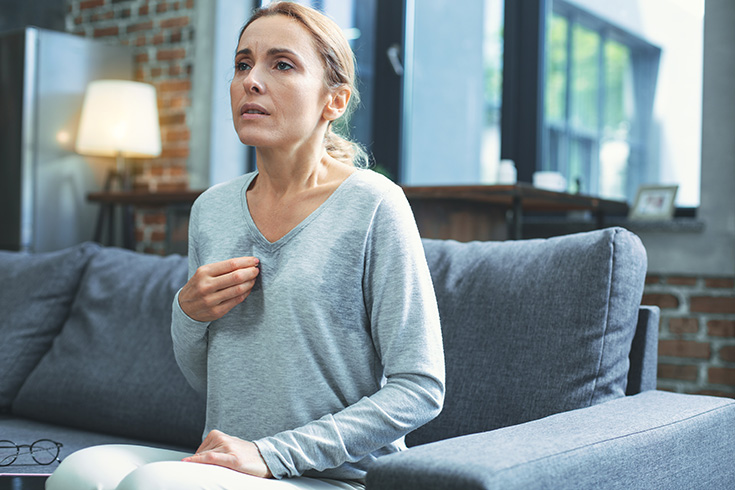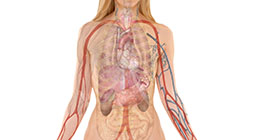
Overview
Symptoms
Causes
Prescription
Health Tips
Historically, menopause was treated as a disease due to its associated symptoms. Today, it is understood menopause is a natural transition in a woman’s life whereby hormones of the fertility cycle slow down, the ovaries stop secreting eggs, and pregnancy is no longer possible. It is not unlike when menstruation begins; some women have a difficult time until their hormones settle into a natural rhythm while other women do not. The menopause transition can be the same with some women having extreme symptoms, while others endure less severe or fewer symptoms.
While the average age of menopause in North America is 52, some women may go through the cycle as early as age 35 and others at age 60.
Perimenopause is the 10-year period leading up to menopause (age 39 to 50). It can generally take about 5 years during perimenopause for periods to cease. Rarely does the menstrual cycle just stop; most often women will experience irregular periods, such as no periods for several months, or two periods in a month, or very long, heavy periods leading up to menopause.
If a woman’s mother or grandmother had an early or late menopause, she may experience the same, but environmental factors like smoking, exercise and nutrition also play a role in when menopause occurs. At any age, menopause may occur abruptly if the ovaries and uterus are removed surgically (hysterectomy), or a woman is exposed to radiation or other menopause-inducing medications.
Menopause symptoms normally only last for about 18 months; if they last longer then other contributing factors like adrenal fatigue or a low functioning thyroid should be investigated.
Symptoms
Menopause is different for every woman. Women consuming a standard North American diet tend to have more or worse menopausal symptoms than women eating traditional diets. Those with low thyroid and exhausted adrenals also experience a more severe menopause transition. Women who had difficult periods when menses first started are more likely to have difficult menopausal symptoms.
On average, 70 to 80 percent of women will experience mild to moderate symptoms, while 10 to 20 percent of women will suffer with severe symptoms. Sex hormones naturally decline after menopause. However, many of the symptoms leading up to and during the first few years of menopause are due to the erratic hormone fluctuations that start to occur during perimenopause. It is important to note that not every woman will experience all the symptoms of menopause. Some women do not get hot flashes and night sweats but may have extreme mood swings, anxiety or depression. No two women are alike when experiencing menopause.
Physical symptoms include:
- Decreased libido: Physical health changes such as vaginal dryness, and mental health changes such as depression combined with decreasing sex hormones can decrease libido and sensitivity making arousal more difficult.
- Fatigue: Night sweats, insomnia, adrenal fatigue, low thyroid function, low iron levels, increased inflammation, and changing hormone levels can all cause fatigue and weakness.
- Hot flashes and night sweats: Between 60 to 80 percent of menopausal women report having hot flashes and night sweats, which can last for several months to years. A low functioning thyroid and increased levels of stress may contribute to fatigued adrenals, being overweight, or smoking; all of which contribute to the severity and duration of hot flashes.
- Increased risk of bone loss: In the first few years after menopause collagen levels decline. Collagen is a protein that makes bones strong and helps reduce the risk of osteoporosis. Collagen decline after menopause increases the risk of osteoporosis. Increased inflammation due to low progesterone, or surging and declining estrogen levels increase bone loss and the inability to rebuild adequate bone.
- Increased risk of heart disease: Declining levels of progesterone increase the risk of heart disease. Estrogen hormone replacement therapy, low thyroid that is not treated properly, lack of exercise, diet and stress contribute to an increased susceptibility to heart disease after menopause.
- Irregular cycles: Technically a symptom of perimenopause, some women may start experiencing irregular periods in the years leading up to menopause. Cycles may occur multiple times in a month, last longer than 5 to 7 days, become very heavy, or stop for a few months and then return again.
- Joint pain: Many women experience joint pain during menopause. Decreasing levels of estrogen can cause an increase in inflammation leading to joint pain. Other factors such as dehydration, inactivity, poor diet, and being overweight may also contribute to joint pain.
- Migraine headaches: Some women experience migraines for the first time, or more severe migraines during menopause due to declining levels of progesterone. Women who experience premenstrual migraines when younger often find their migraines worsen at menopause.
- Nausea: Decreasing levels of progesterone, surges of estrogen, synthetic hormone replacement therapy (SHRT), water retention and vertigo can all cause nausea.
- Recurring urinary tract or vaginal infections: Decreasing estrogen in the urogenital area causes the walls of the vagina and urinary tract to become thinner and more sensitive. In addition, pH changes due to fluctuating hormones may increase levels of bacterial growth. Interestingly, vaginal pH greater than 4.5 is a more accurate diagnosis of menopause than a blood test for Follicle Stimulating Hormones (FSH test).
- Urinary incontinence (aggravated by coughing, sneezing or laughing): Decreasing levels of urogenital estrogen in tissues of the vagina and urethra may cause incontinence.
- Vaginal itching and dryness: Decreasing levels of estrogen in vaginal tissues can cause vaginal itching, dryness, and thinning (atrophy) of the vaginal wall. While women of any age may experience vaginal dryness, rates increase in menopausal and postmenopausal women.
- Weight gain: Surging estrogen levels prior to and during the first couple years of menopause can lead to mid-section weight gain around the hips, thighs and abdomen. Estrogen can also block the uptake of thyroid hormone leading to low thyroid function and weight gain. Sleeping difficulty, genetics, and stressed adrenals may also lead to weight gain during menopause.
Psychological symptoms may include:
- Anxiety: Hormonal changes are associated with heightened anxiety and increased frequency of panic attacks during perimenopause and menopause. A decline in progesterone and pregnenolone at menopause can contribute to the initiation of anxiety. When estrogen levels are low serotonin is also low increasing the risk of anxiety and unstable moods. Insomnia, stress, physical and mental changes during menopause can all increase anxiety levels.
- Changes in cognitive function such as brain fog or memory problems: Fluctuating estrogen and progesterone levels can affect memory and the ability to learn new things. However, once menopause is over memory usually returns to normal.
- Depression, mood swings, “crying spells”, irritability: Estrogen boosts serotonin, the happy hormone, while progesterone acts on the neurotransmitter gamma-aminobutyric acid (GABA) receptors producing a calming effect. Thus, both serotonin and GABA help ward off depression and anxiety and aid restful sleep. A reduction in estrogen can cause a serotonin imbalance causing feelings of sadness and hopelessness. Women who experienced severe PMS when younger are more likely to suffer from mood imbalances at menopause.
- Problems with sleep: Low progesterone and estrogen levels, night sweats, adrenal exhaustion, and too much stress, anxiety or depression can all increase sleep disturbances for menopausal women.
Low Thyroid Function, Perimenopause, Menopause and Weight Gain: Estrogen decides body fat distribution, and, in women, fat is stored on the hips, bottom, abdomen and thighs. Fat cells manufacture and store estrogen. Some researchers believe women get an increase in body fat around menopause to ensure adequate estrogen from fat cells. Others believe that it is low thyroid and exhausted adrenals that promote mid-section fat gain. Considering that excess fat reduces our life expectancy, I tend to believe the latter because the body is generally programmed to ensure our survival.
Around 30 percent of people over the age of 35 could be walking around with subclinical low thyroid function. We know that low thyroid function promotes many hormonal problems that could be remedied with thyroid-supporting nutrients or medication (thyroid hormones).
During the perimenopausal years (the 10 to 15 years before menopause) and during menopause (menopause means one year with no periods), it is common for women to suffer a multitude of hormonal complaints. Hot flashes, night sweats and sleep disturbances are common complaints during this time in a woman’s life. Most think these symptoms are associated with a decline in estrogen, but they are also hallmark symptoms of low thyroid, especially night sweats and insomnia. Most menopausal women are given hormone replacement therapy with estrogen for these symptoms. Perimenopausal women may be put on the birth control pill. The problem with these treatments is that estrogen further shuts down the thyroid: high estrogen levels interfere with the thyroid hormones, particularly the utilization of T3, the most biologically active thyroid hormone. Too much estrogen, either from hormone replacement therapy, the body’s own estrogen, or the environment, causes a host of problems and also impairs thyroid function.
Many women experience a 10- to 15-pound weight gain and increased blood pressure when they start taking synthetic estrogen at menopause. This happens because estrogen is an antagonist to thyroid hormone, and the metabolic rate slows down. As this happens, many women develop difficulties with fat metabolism, because one of the functions of the thyroid hormones is to stimulate fat cells to burn fat. Weight control problems result.
In addition, serum cholesterol or triglyceride levels may increase. Thyroid activity can also be inhibited by high levels of androgens (male sex hormones) circulating in the blood. Depression and fatigue are the most common thyroid symptoms in menopausal women.
Causes
Menopause is a natural event in a woman’s life. Every woman will go through menopause, but there is some speculation about how menopause begins. Does the brain stop signaling the hormones to stimulate the follicles, or do the follicles stop listening to the brain’s signals? It could be both, and may be influenced by genetic predisposition and environmental factors such as activity levels, childbearing, exposure to environmental hormones, poor diet, low-calorie diets, and severe emotional stress.
During natural menopause, the ovaries slow down their production of estrogen, and the adrenal glands must compensate by producing the precursor hormones DHEA (dehydroepiandrosterone) and androstenedione, which can be converted to estrogen. Fat cells and the uterus also produce estrogen. The liver then processes and packages these hormones, while thyroid hormones are also involved.
What is the difference between a woman who has no symptoms at menopause and a woman who suffers with a multitude of the symptoms mentioned above? Women with exhausted adrenals, low levels of thyroid hormones, and a congested liver will have more severe menopause symptoms compared to women with a healthy liver, healthy adrenals, and adequate thyroid hormones.
It is unfortunately ironic that most women are estrogen deficient at menopause, yet they may also be exposed to toxic environmental estrogens that contribute to hormonal problems and increase the risk of breast and ovarian cancer at menopause.
Surgical and Premature Menopause
Other causes of menopause are premature menopause, oophorectomy (removal of the ovaries), and hysterectomy (removal of the uterus). Premature menopause will happen to one out of 1000 women between the ages of 15 and 29, and one out of every 100 women aged 30 to 39. Only one-third of those cases will have a traceable cause such as immune dysfunction, infection, metabolic or systemic disease, smoking, reduced blood supply to the ovaries, chemotherapy, surgery, or radiation.
The removal of the ovaries and uterus may be done at the same time or separately and is referred to as surgical menopause. Removal of the ovaries brings on menopause immediately and the symptoms can be overwhelming due to the sudden decline in hormone production. A hysterectomy in which at least one ovary remains induces a more natural, albeit earlier, menopause.
Prescription for Health
No one needs to feel tired, worn down, brain-fogged, or lacking in vitality during menopause. The goal should be to feel fantastic and fabulous! There are no more periods to worry about, and no more concerns about potential pregnancy.
Menopause should be all about a time when a woman can focus on herself. A time to choose to eat right, exercise, and start new hobbies and activities that could not be done when children were young or one’s career was in full swing.
Eighty percent of women can transition through menopause using diet, lifestyle changes and nutritional and herbal supplements. The other 20 percent of women will need low dose, short-term, bioidentical hormones, accompanied by dietary and lifestyle changes, and nutritional and herbal supplements.
Is Hormone Replacement Therapy Advised?
Every woman is unique. So how is it that a one-size-fits-all prescription for synthetic estrogen and/or progesterone (progestins) has been given to millions of women for decades? The simple answer: marketing. In July 2002, the Women’s Health Initiative (WHI) study that examined hormone replacement therapy (HRT) use in 16,608 women was prematurely halted for safety reasons. Combination Premarin® and Provera® (synthetic estradiol estrogen and progestins) HRT was found to cause a 41 percent increase in stroke, a 29 percent increase in heart attacks, a doubled risk of blood clots, a 22 percent increase in cardiovascular disease and a 26 percent increase in the risk of invasive breast cancer. Researchers stopped the estrogen-only arm of this study in 2004 due to an increased risk of stroke, dementia and mild brain damage.
Update directly from the WHI published in Jama May 2024;331;(20):1748-1760.
“The WHI clinical trial results do not support hormone therapy with oral conjugated equine estrogens plus medroxyprogesterone acetate for postmenopausal women or conjugated equine estrogens alone for those with prior hysterectomy to prevent cardiovascular disease, dementia, or other chronic diseases. However, hormone therapy is effective for treating moderate to severe vasomotor and other menopausal symptoms. These benefits of hormone therapy in early menopause, combined with lower rates of adverse effects of hormone therapy in early compared with later menopause, support initiation of hormone therapy before age 60 years for women without contraindications to hormone therapy who have bothersome menopausal symptoms. The WHI results do not support routinely recommending calcium plus vitamin D supplementation for fracture prevention in all postmenopausal women. However, calcium and vitamin D are appropriate for women who do not meet national guidelines for recommended intakes of these nutrients through diet. A low-fat dietary pattern with increased fruit, vegetable, and grain consumption did not prevent the primary outcomes of breast or colorectal cancer but was associated with lower rates of the secondary outcome of breast cancer mortality during long-term follow-up.
Conclusions and Relevance For postmenopausal women, the WHI randomized clinical trials do not support menopausal hormone therapy to prevent cardiovascular disease or other chronic diseases. Menopausal hormone therapy is appropriate to treat bothersome vasomotor symptoms among women in early menopause, without contraindications, who are interested in taking hormone therapy.”
Thankfully, less than 20 percent of all menopausal women need some form of hormone therapy to combat extreme, uncontrollable hot flashes and night sweats; as noted above, the rest find relief using herbal, vitamin, and mineral supplements, alongside lifestyle and dietary changes.
The recommendations below are intended to help women go through menopause symptom-free, with plenty of energy and a healthy libido, and without the worry of an increased risk of heart disease and osteoporosis. Synthetic hormone replacement therapy (SHRT) is not advised due to the cancer-causing, heart disease promoting risks involved. If one decides to take HRT, make sure that a natural estrogen, DHEA or progesterone is used under the guidance of a naturopathic physician.
Bioidentical Hormones: A Safer Option
Bioidentical hormones are a safe and effective option for women needing short-term relief of severe menopausal symptoms. Bioidentical hormones are identical in chemical structure to the body’s own hormones. While some are available premade by prescription, such as Prometrium (bioidentical micronized, oral progesterone in capsules), most bioidentical hormone products must be compounded by a pharmacist based on a dosage specific to a patient’s needs.
The main types of estrogen are estrone, estradiol and estriol. Estriol is the estrogen recommended because it is without the risk of developing cancers. Estriol has many credible studies showing its positive effects for urinary incontinence and urgency and vaginal dryness. In Europe, topical estriol has been used for decades for wrinkles. Estriol is the only safe estrogen as it does not cause a thick uterine lining, change breast cells, or increase the risk of estrogen related cancers.
The recommended dosage for intra-vaginal estriol is 0.5 mg to 1 mg once daily for three weeks, then 0.5 mg to 1 mg once weekly for six months. Follow with examination to determine if vaginal atrophy is improving. If there is improvement, discontinue using estriol, or use 0.5 mg to 1 mg once every other week for another six months.
| Nutrient | Dosage | Action |
|---|---|---|
| Chaste tree berry (Vitex)* | 320 mg | Support proper hormone secretion; controls hot flashes |
| Dong quai* | 400 mg | Balances estrogen activity; tones the uterus; reduces spasms; beneficial for the cardiovascular system |
| Black cohosh* | 320 mg | Reduces depression, insomnia, vaginal dryness
Non-estrogenic, found safe for those with estrogen-receptor-positive breast cancer |
| Hesperidin* | 300 mg | Stops hot flashes and night sweats; stops night leg cramps |
| Gamma oryzanol* | 300 mg | Relieves hot flashes; supports pituitary function and promotes endorphin release by the hypothalamus thereby improving mood
Lowers triglycerides and total cholesterol |
| Sage leaf* | 300 mg | Alleviates sweating, hot flashes and night sweats |
| Rhodiola**
(Rhodiola rosacea) |
100 mg | Helps reduce the effects of stress, is anti-aging, regulates the heart by increasing oxygen utilization |
| Suma**
(Pfaffia paniculata) |
100 mg | A regenerative tonic used for nervous, reproductive, hormonal and digestive disorders |
| Sensoril® Ashwagandha**
(Withania somnifera) |
62.5 mg | Improves energy, supports the immune system, is antioxidant and anti-inflammatory, improves sexual performance
Aids conversion of T4 to T3 thyroid hormone |
| Schizandra berries**
(Schizandra chnensis) |
80 mg | For insomnia, nervousness, supports the liver, improves physical endurance. |
| Personal Lubricant | Apply desired amount when needed | Free of parabens, toxic preservatives, petroleum-derived ingredients and animal products; relieves vaginal dryness and irritation |
| Vitamin C with bioflavonoids (particularly hesperidin) |
600 mg daily, 100 mg citrus bioflavonoids | Decreases the number of hot flashes; hesperidin, a bio-flavonoid, also reduces nighttime leg cramps |
| St. John’s Wort | 100 mg two times daily | Increases serotonin levels; reduces anxiety, muscle pain; improves sleep and early morning stiffness.
Enhances mood; controls appetite |
| Melatonin | 3 mg at bedtime | Improves sleep |
| Omega-3 Fatty Acids CALA-Q Plus |
4 softgels daily containing: Calamari oil providing 800 mg of DHA and 200 mg of EPA | Relieves breast pain; may alleviate hot flashes |
| B-complex vitamins (in their active coenzyme form) Bsmart |
Look for a minimum of the following per daily dose:
B1 – 100mg B2 – 7.5 mg Niacin – 353 mg B5 – 300 mg B6 – 100 mg B12 – 1000 mcg Folate – 1000 mcg |
Improves mood and reduces anxiety; aids hormonal balance B vitamins in their active coenzyme form are more easily absorbed |
Health Tips to Enhance Healing
- Add flax seeds, fennel, chickpeas, and lentils to diet for their hormone-balancing actions.
- Address any underlying thyroid and adrenal imbalance or gut dysbiosis like overgrowth of Candida albicans (candidiasis).
- Consult a medical doctor for referral to a dual energy X-ray absorptiometry (DEXA) scan to check bone density. DEXA is the gold standard for determining osteoporosis.
- Consume a diet rich in cruciferous vegetables (broccoli, Brussels sprouts, cauliflower, cabbage and kale); at least two half-cup servings per day. Cruciferous vegetables contain indole-3-carbinol (I3C) and sulforaphane, which help to balance hormones and reduce the risk of breast cancer.
- Enjoy sexual relations twice a week to prevent vaginal atrophy and to maintain high levels of immune function. For vaginal dryness, use a non-toxic, paraben-free personal lubricant.
- For urinary incontinence, do Kegel exercises daily to strengthen pelvic floor (urination) muscles. Consider a vaginal estriol prescription, 0.1 mg per day for three to six months. Research has shown this simple prescription can eliminate urinary incontinence in 80 percent of women.
- Have thyroid tested to rule out a low functioning thyroid.
- Menopause can be a beginning rather than an end. Try things that were not possible while raising children or building a career.
- Reduce stress and support the adrenal glands.
- Walk briskly every day for 30 minutes to cut hot flashes by 50 percent, while improving heart and bone health.











